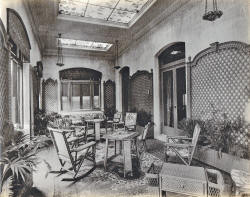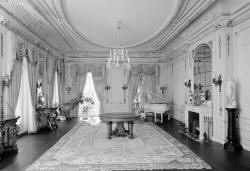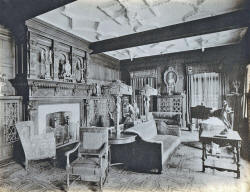|
Corinthian Hall: the “Palace” |
|
Corinthian Hall receives its name from the six columns of monolithic size supporting the front portico. Constructed of solid limestone, 25 ft. high and 2 ˝ ft. in diameter, the columns were of such extravagant cost Henry Ford Hoit (architect) suggested them as an alternative. But Long, who wanted a dramatic entrance to his house, insisted on their use. Hoit did not want overhead wires to mar the beauty of the site. Therefore the garage contained a generating plant in the basement. The lines, including phone, ran underground throughout all the buildings. The sun parlor at Corinthian Hall had green lattice work on the walls, potted ferns and chintz covered wicker furniture. None of the 70 rooms contained a single piece of antique furniture as Mr. Long thought it ridiculous to buy something old and “full of worm holes” and what he considered “second hand”. Corinthian Hall presented an ultra fashionable mix of period rooms, principally French and English. Exceptions, of course, were the service areas, the bowling alley, and Long’s full-equipped barbershop next to his bedroom. The love of period rooms during the Gilded Age was so strong that even the billiard room in the basement boasted a strong English manor house flavor with black walnut beams and an intricately carved massive fireplace. The living room was located to the right of the entrance hall, directly across from the grand salon. The predominant colors were slate blue and gold. Though Mrs. Long’s favorite, the library across the west hallway from the grand salon was Mr. Long’s private retreat. Each morning he would come there to read passages from the Bible. The bedrooms were solidly French and exceptionally large, with connecting sitting rooms, spacious dressing rooms and baths. By December 1910, all was in readiness for the Longs’ occupancy at Corinthian Hall. Unmistakably, Corinthian Hall is a regal place, with distinguished architecture, justly deserving the homage it was paid November 14, 1980, when the mansion entered the rolls of the National Register of Historic Places. More palace than house, its style and construction are an honest reflection of the achievements of the man who lived there and the aesthetics of the Gilded Age in which it was built. The Kansas City parade had never seen banner-Beaux-Arts or otherwise – like the palace at the crest of the hill on Gladstone. Nor will again. |


